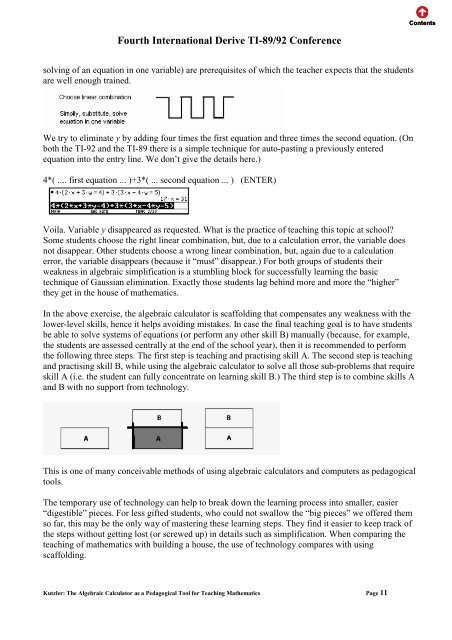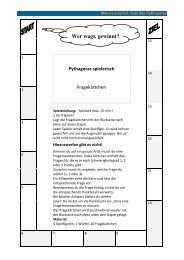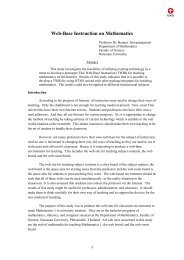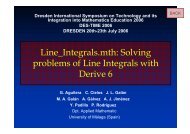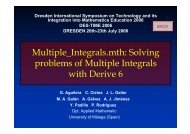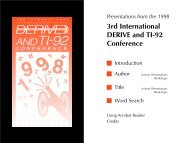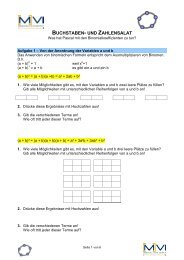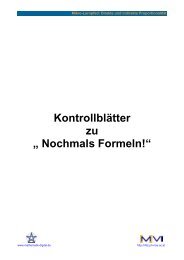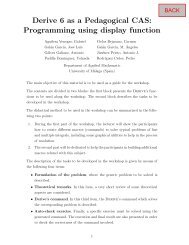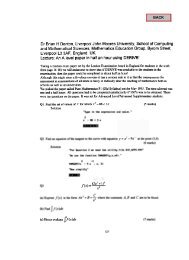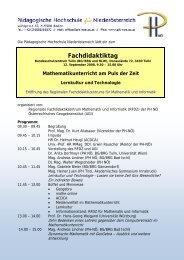The Algebraic Calculator as a Pedagogical Tool for Teaching ...
The Algebraic Calculator as a Pedagogical Tool for Teaching ...
The Algebraic Calculator as a Pedagogical Tool for Teaching ...
Create successful ePaper yourself
Turn your PDF publications into a flip-book with our unique Google optimized e-Paper software.
Fourth International Derive TI-89/92 Conference<br />
solving of an equation in one variable) are prerequisites of which the teacher expects that the students<br />
are well enough trained.<br />
We try to eliminate y by adding four times the first equation and three times the second equation. (On<br />
both the TI-92 and the TI-89 there is a simple technique <strong>for</strong> auto-p<strong>as</strong>ting a previously entered<br />
equation into the entry line. We don’t give the details here.)<br />
4*( .... first equation ... )+3*( ... second equation ... ) (ENTER)<br />
Voila. Variable y disappeared <strong>as</strong> requested. What is the practice of teaching this topic at school?<br />
Some students choose the right linear combination, but, due to a calculation error, the variable does<br />
not disappear. Other students choose a wrong linear combination, but, again due to a calculation<br />
error, the variable disappears (because it “must” disappear.) For both groups of students their<br />
weakness in algebraic simplification is a stumbling block <strong>for</strong> successfully learning the b<strong>as</strong>ic<br />
technique of Gaussian elimination. Exactly those students lag behind more and more the “higher”<br />
they get in the house of mathematics.<br />
In the above exercise, the algebraic calculator is scaffolding that compensates any weakness with the<br />
lower-level skills, hence it helps avoiding mistakes. In c<strong>as</strong>e the final teaching goal is to have students<br />
be able to solve systems of equations (or per<strong>for</strong>m any other skill B) manually (because, <strong>for</strong> example,<br />
the students are <strong>as</strong>sessed centrally at the end of the school year), then it is recommended to per<strong>for</strong>m<br />
the following three steps. <strong>The</strong> first step is teaching and practising skill A. <strong>The</strong> second step is teaching<br />
and practising skill B, while using the algebraic calculator to solve all those sub-problems that require<br />
skill A (i.e. the student can fully concentrate on learning skill B.) <strong>The</strong> third step is to combine skills A<br />
and B with no support from technology.<br />
This is one of many conceivable methods of using algebraic calculators and computers <strong>as</strong> pedagogical<br />
tools.<br />
<strong>The</strong> temporary use of technology can help to break down the learning process into smaller, e<strong>as</strong>ier<br />
“digestible” pieces. For less gifted students, who could not swallow the “big pieces” we offered them<br />
so far, this may be the only way of m<strong>as</strong>tering these learning steps. <strong>The</strong>y find it e<strong>as</strong>ier to keep track of<br />
the steps without getting lost (or screwed up) in details such <strong>as</strong> simplification. When comparing the<br />
teaching of mathematics with building a house, the use of technology compares with using<br />
scaffolding.<br />
Kutzler: <strong>The</strong> <strong>Algebraic</strong> <strong>Calculator</strong> <strong>as</strong> a <strong>Pedagogical</strong> <strong>Tool</strong> <strong>for</strong> <strong>Teaching</strong> Mathematics Page 11


